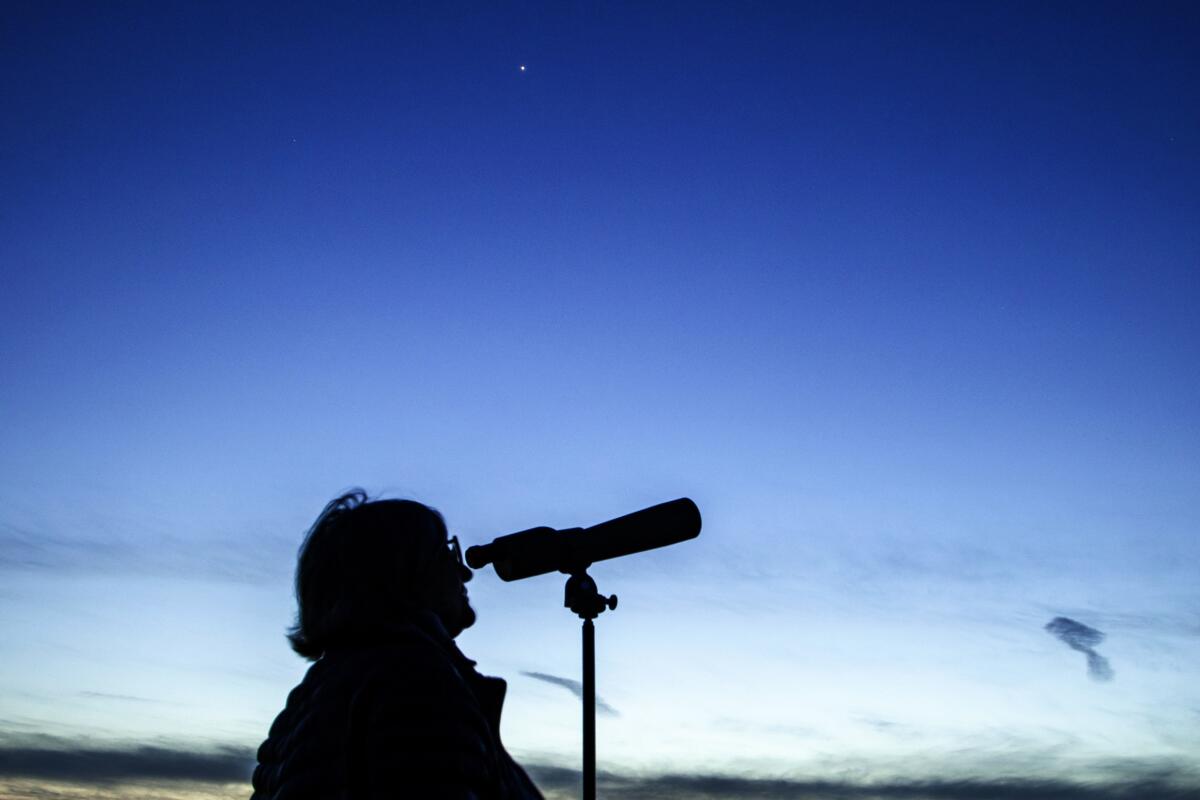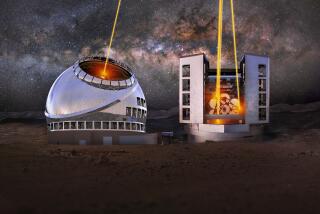Op-Ed: Satellites may devastate research astronomy. How we can save the night sky for science

For at least 3,000 years, humans have documented patterns in the night sky. The periodic motions of celestial bodies across the sky told our ancestors when to hunt certain foods and plant crops, and how to navigate the oceans. Less than a century ago, everyone could look up and see a starry sky. That’s no longer true. Widespread urban light pollution has made it hard to see more than a handful of stars in many cities around the world.
A set of relatively new interlopers, artificial satellites, is causing more light pollution with each passing year. As they reflect sunlight from their high-altitude orbits, these satellites look just like stars moving across the sky. As of now, satellites are a novelty to be tracked and pointed out, but we’re about to transition from gawking at them to seeing them overrun the night sky in the next three to five years.
While this will continue to be annoying for casual stargazers, it will be devastating for research astronomy.
SpaceX’s Starlink program has about 1,840 satellites in orbit, with provisional approval to launch 40,000 more, which is 10 times the total number of satellites currently in orbit. The purpose of this new megaconstellation of satellites, also called a satcon, is to provide internet access to customers worldwide, particularly rural dwellers who are struggling without it during the work-from-home years of the pandemic.
SpaceX is at the forefront of a new space race among private companies, with credible progress being made toward having at least 65,000 satellites in the sky operated by multiple companies. What might this future night sky look like?
Within two hours of sunrise or sunset, dozens to hundreds of satellites will be visible to the naked eye, creeping across the sky in all different directions in front of the stars, according to research my colleagues and I published last month in the Astronomical Journal.
This new form of light pollution would occur the world over. It won’t matter if you’re in the suburbs, or in one of the 18 official dark sky preserves or at the North Pole. When you look up at the night sky, one of every 15 points of light you can see with your own eyes will be moving satellites. They will completely change the night sky as we know it.
Astronomers rely on totally dark skies to detect distant stars and galaxies that are so faint and tiny that huge telescopes have to gather light for minutes or hours at a time using powerful, sensitive cameras to capture an image. Thousands of sunlit satellites in the sky above each dark-sky telescope location will soon get in the way.
For my astronomy research, I’m searching at the edge of our solar system for new icy worlds that are millions of times fainter than a typical Starlink satellite. By my calculations, several Starlinks will fly through each of my telescope images in the very near future. It’s like trying to stargaze while someone periodically shines a laser pointer in your eye.
Light pollution from satcons is worst close to twilight, when telescope observation is vitally important to the discovery and careful orbital measurement of potentially hazardous asteroids. Early discovery of an object that could crash into the Earth is crucial to preventing it from happening. Society’s twisted, lackluster reaction to the discovery of a hazardous comet careening toward Earth is at the heart of the satirical movie “Don’t Look Up,” but what happens when we can’t look up?
We can’t just send more telescopes into space. Building and launching them costs at least 10 times as much as a significantly larger telescope that will be used on Earth. Despite having a smaller mirror than many ground-based telescopes, the recently launched James Webb Space Telescope is the most expensive such device ever built. At a cost of nearly $10 billion, it will consume a significant portion of NASA’s astrophysics budget over many years. Additionally, the Hubble Space Telescope, launched in 1990, and most other space telescopes are in low-Earth orbit — along with thousands of their new satcon neighbors — and are already hampered by light pollution from satellites.
These satcons won’t end astronomy research, but they will make it much more difficult, potentially causing us to lose 30% of our images to streaks caused by Starlink satellites alone. Some useful data can be extracted from a satcon-photobombed image, but it takes great computational and logistical effort.
The advent of a sea of satcons in space means that fewer groundbreaking (and potentially Earth-saving) astronomy discoveries will be made, primarily because of the actions of one private American company: SpaceX.
The only way the night sky can be saved is for satcon operators to make their satellites fainter or launch fewer of them. The Starlink program voluntarily tried painting one satellite black, but it overheated and quickly failed. Sunshield visors were added to some of its newer satellites in an attempt to make them too faint to see with the naked eye, but they didn’t work as well. SpaceX needs to put more engineers on this vexing problem.
Despite these permanent, sky-changing drawbacks (as well as other pollution issues), providing internet access through satcons will hugely benefit a relatively small number of people. One possible solution would be to make satellite-internet service unnecessary. Instead, states and municipalities could invest in internet infrastructure such as rural broadband via fiberoptics or cell networks. At great cost to the world, the Starlink program provides a way for governments to avoid the expense of creating an internet infrastructure. No wonder they aren’t complaining.
With better engineering, perhaps a compromise could be reached.
SpaceX regularly lands rockets on drone ships in the ocean; its talented engineers ought to be able to make satellites fainter. They should figure out how to use fewer satellites to provide coverage for customers or share satellite infrastructure, as cell companies do with cell towers. SpaceX could help save astronomy research by contributing funding to offset the extra costs researchers will face while avoiding light pollution from its satellites.
We astronomers have absolutely no legal power over these huge international corporations. They will likely only respond to international legislation that may be very slow in coming. Consumer pressure can be applied: If customers have an alternative, they can choose not to subscribe to satellite internet. They can talk to their representatives in all levels of government and ask them to support other types of rural internet infrastructure — and to properly regulate satellites in orbit. They can also join an organization that’s actively fighting light pollution, such as the International Dark Sky Assn.
Sure, satellites are impressive feats of engineering, but beyond them lie comets, exoplanets, black holes, galaxies and more fantastical physics than we can currently imagine. To know them, we need to be able to see them.
Samantha Lawler is an astronomer and an assistant professor at Campion College and the department of physics at the University of Regina in Canada.
More to Read
A cure for the common opinion
Get thought-provoking perspectives with our weekly newsletter.
You may occasionally receive promotional content from the Los Angeles Times.










